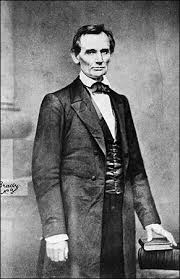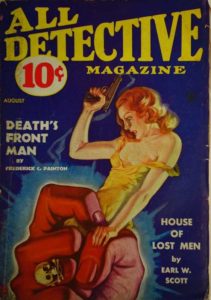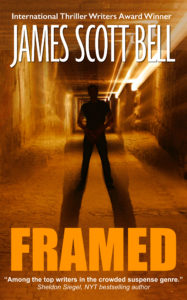by James Scott Bell
@jamesscottbell
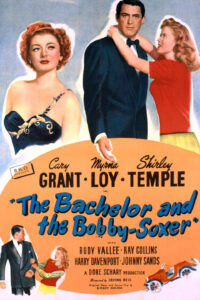 One of my favorite comedies from the 1940s Is The Bachelor and the Bobby-Soxer. This little gem (with an Academy Award-winning screenplay by Sidney Sheldon) stars Cary Grant as the bachelor, Shirley Temple as the bobby-soxer, and Myrna Loy as a judge who happens to be Shirley’s big sister.
One of my favorite comedies from the 1940s Is The Bachelor and the Bobby-Soxer. This little gem (with an Academy Award-winning screenplay by Sidney Sheldon) stars Cary Grant as the bachelor, Shirley Temple as the bobby-soxer, and Myrna Loy as a judge who happens to be Shirley’s big sister.
The plot is simple. Grant gives a speech at Shirley’s high school, and Shirley becomes infatuated with him. Grant has to fight her off even as her suspicious sister brings the arm of the law down upon him. I’ll bet you can guess who Grant ends up romancing. It’s all great fun, especially a scene where Grant takes on the persona of a teenager for a little bit of payback.
There’s one scene I’ve always found of quaint historical interest. Grant is alone in his apartment. It’s evening, he has on a comfortable robe. He mixes himself a highball and turns the radio to soft music. Then he happily settles into a chair and takes up… a book! He has looked forward to this all day—an uninterrupted hour or two of reading pleasure. Of course, that’s when Shirley interrupts things, having sneaked into his apartment to be near him!
There used to be a time when an evening’s entertainment was sitting in a chair with a drink or a cup of tea and reading a book. The Bachelor and the Bobby-Soxer came out in 1947, just before the explosion of television. How many people even think of a book as an option for prime time anymore?
These thoughts came to me recently when I was knocked flat by a 24-hour bug. It was a nasty sucker. I spent an entire day in bed doing absolutely nothing but moaning and drifting in and out of sleep. There was a junkyard tire fire in my stomach. My head felt like a mastiff’s chew toy.
The next day I was marginally better, but certainly not ready for Irish folk dancing. I managed to get a little writing done, but then just wanted to go back to bed. Only I didn’t want another day of pitiful do-nothingness. What about reading a book?
I’d recently purchased the massive biography of Cornell Woolrich, First You Dream, Then You Die. I considered it a sign of recuperation that I could lift it. And actually open it and begin to read. Ah! I’d forgotten what a pleasure it is to read a physical book in bed when it isn’t nighttime. (When I try this at night I can manage only three or four pages before the sandman does his thing.)
This time I was into a book for a couple of hours, occasionally closing my eyes and dozing, but waking to read again.
These days I (and, I suspect, most of you) have to snatch time to read a book. Too many other things demand our attention. Speed and the false god Multitask have killed contemplation. We have sacrificed the aesthetic on the altar of the frenetic.
It’s not that I don’t appreciate (and still with awe) the magnificence of the ebook. Having innumerable electronic volumes available on my phone (via Kindle app and Overdrive) means I can read anything I want at a moment’s notice. No more flipping through last May’s issue of Working Woman in the waiting room! No, let’s see how big a bite I can take out of Martin Chuzzlewit…just open the complete works of Dickens!
Yet I still like holding a physical book, and my recent indisposition reminded me how much I miss a good, long stretch of pure reading time. It’s my fault, of course. Almost always my first choice in the evening is something on the flat screen.
But do I really need an hour of what used to be called “news” but is now little more than an oral version of Friday Night SmackDown? How much of must is really there in “must-see TV” (not much!). How many hours of my life are unredeemed by tuning into the latest “can’t miss” series which, once I’ve taken in an episode or two, I wish I’d actually missed?
Okay, there’s football three or four nights a week, but that’s what the DVR and pause button are for (I can skip time outs, commercials, and halftimes—with apologies to Phil, Curt, Michael, Terry, Howie, Coach, Boomer, Jimmy, Tony, Spanky, Fozzie, Gonzo and whoever else expands time with erudite comments like, “The defense really needs to step up.”)
So, dear friends, why don’t I just get into the habit of reading a book after dinner?
If it was good enough for Cary Grant, it should be good enough for me!
When was the last time you curled up with a good (physical) book for at least an hour? How have your reading habits changed over the last couple of decades? Do you have a favorite “curl-up-with” book?
***
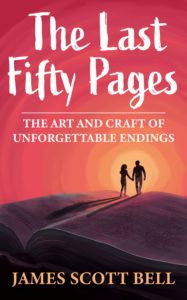 BTW, if your preferred method of curling up these days is audio, and you’re a writer, you might be interested to know that I have another of my writing books available through Audible. Narrated, natch, by me. The Last Fifty Pages: The Art and Craft of Unforgettable Endings.
BTW, if your preferred method of curling up these days is audio, and you’re a writer, you might be interested to know that I have another of my writing books available through Audible. Narrated, natch, by me. The Last Fifty Pages: The Art and Craft of Unforgettable Endings.

